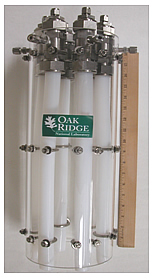Initial research by ORNL using carbon dioxide and simulated saline produced water defined the concept and verified the concept feasible for significantly reducing salt concentrations in the water. Initial laboratory tests conducted showed the hydrate process capable of reducing the salt level in the synthetic produced water from 35,000 to 2,000 ppm. Background work, such as operator surveys, database searches, and literature review were completed. The literature survey involved locating and reviewing applicable NEPA (National Environmental Policy Act) documents, such as Environmental Assessments and Environmental Impact Statements, that were completed by producers with CBNG leases in the Greater Green River Basin (GGRB). An extensive listing is provided in a report, which will be used by the project team and provided to DOE/NETL. The NEPA documents are available electronically on the Wyoming Bureau of Land Management website (http://www.wy.blm.gov" [external site]).
A review of the Wyoming Oil and Gas Conservation Commission (WOGCC) databases was completed to acquire well data on permitted CBNG wells in the GGRB. In October-November 2005, data from the website (http://wogcc.state.wy.us/) were downloaded and entered into an Access database developed by BCT personnel. This database was checked and updated in December 2005, April 2006, and November 2006. Additional updates continued through the spring and summer of 2007 to add new wells and update production statistics. Tracking the well data in this fashion has provided considerable useful data on the level of permitting activity, operators, well locations, well depths, producing formations, production activity, and to a limited extent, water quality data for currently producing CBNG wells in the basin. This database will continue to be updated periodically until it is used to identify a suitable producing CBNG well in the GGRB for the field demonstration.
Laboratory-scale experiments were conducted by ORNL using the synthetic brines and varied gas compositions. Methane hydrate formation was investigated in a series of laboratory-scale experiments, propane hydrate formation in another series and a final series in which a gas mixture of 95% methane and 5% propane was used to form the hydrate. Successful hydrate formation was achieved using each of the three gas mixtures. ORNL used the data generated to optimize the performance of their continuous-jet hydrate reactor (CJHR). ORNL communicated results of laboratory-scale experiments and provided BC Technologies, Ltd. (BCT) with a CJHR for initiation of prototype development. For additional information regarding the ORNL research please contact Costas Tsouris (tsourisc@ornl.gov or 865-241-3246).
BCT personnel continued prototype development and started bench-scale experiments in 2007. The primary issues to be addressed were how to operate the CJHR in a continuous or semi-batch mode and the design of the heat transfer systems required for hydrate formation and gas/treated water/brine separation during hydrate dissociation. The CJHR was originally designed by ORNL to discharge hydrate into the deep ocean where substantial pressure exists. In effect, the CJHR discharges into a vessel operating at elevated pressure in the ORNL laboratory-scale experiments. Keeping the hydrate under pressure during dissociation causes operating difficulties related to gas/treated water/brine separation during hydrate dissociation and is difficult to envision in continuous or semi-batch mode operation. Further, the high pressures required by the process and relatively low hydrate density desired would require very expensive equipment to hold the hydrate under pressure during dissociation. However, the CJHR is compact and it was decided to determine if the CJHR could be operated under pressure to form hydrates that could be discharged into low pressure vessels for dissociation. To achieve this objective, an adjustable gas spring and a cone were added to the CJHR outlet to maintain the desired pressure inside the CJHR .
Next, it was decided that control of the initial dissociation of the hydrate could be achieved and controlled by controlling the temperature in the first dissociation chamber. Brine and gas from hydrate dissociation can be easily separated and collected in the first chamber. The remaining solids (hydrates) can then be transferred to a final dissociation chamber where the hydrate is rapidly dissociated using warm water and remaining gas is collected.
Three heat exchange systems were designed for hydrate formation and gas/treated water/brine separation during hydrate dissociation. The first refrigeration system utilizes a standard refrigerant compressor. The compressed refrigerant is cooled and condensed by heating the hydrate produced. The condensed refrigerant is then evaporated cooling a glycol/water solution. The cooled glycol water solution flows into the next heat exchange system and is used to cool the feed water to be treated to a temperature greater than 0°C and less than 8 °C. The glycol/water mixture is used as the feed water cooling media to prevent freezing in the refrigerant evaporators and the feed water heat exchanger. The glycol/water mixture also allows the feed water heat exchanger to operate with an efficient driving force of 5 °C even when a 1°C water temperature is desired. The third heat exchange system also utilizes a standard refrigerant compressor but the compressed refrigerant is air cooled. This refrigeration system is used to control gas temperature in the hydrate collection chamber which operates at atmospheric pressure.
Construction of a bench-scale simulator was initiated in summer 2007 and testing began in 2008. After a lengthy shakedown and modification period, production of carbon dioxide hydrate in the atmospheric chamber was achieved. BC Technologies reported successful continuous bench-scale testing with the ability to lower TDS levels from >10,000 to < 1,000. Cleaner water had been generated with hydrate formation. BC Technologies has modified the operational unit for continuous field operation at a location in the Green River Basin. Current plans are to conduct simulations of hydrate dissociation to determine brine and treated water yields and qualities, and to complete the design of the gas collection and recompression systems. BC Technologies will determine the economic feasibility of the water treatment process.




